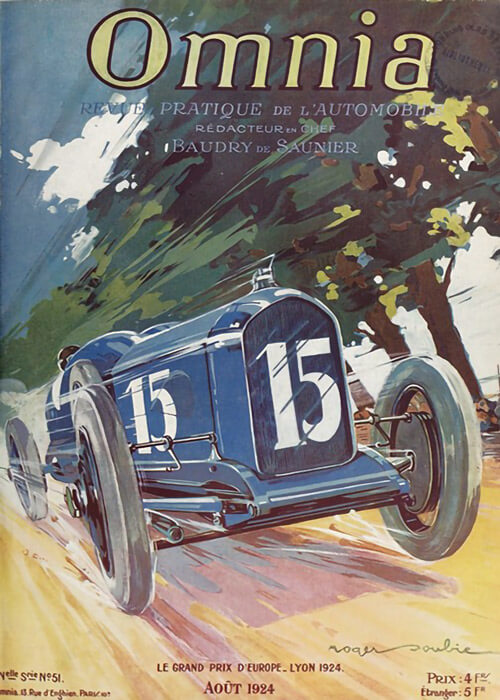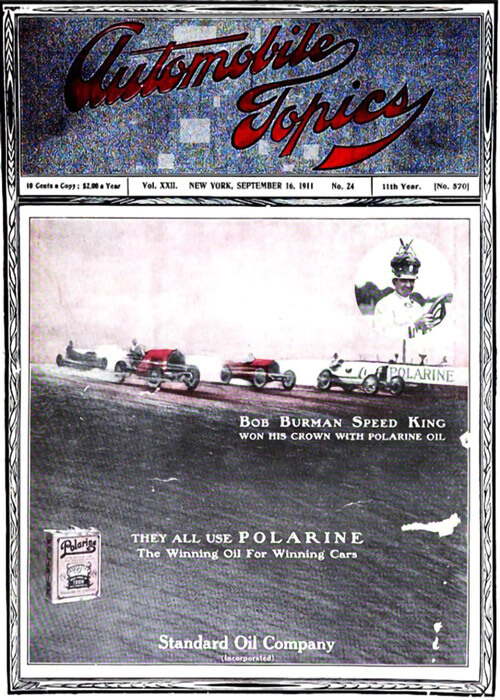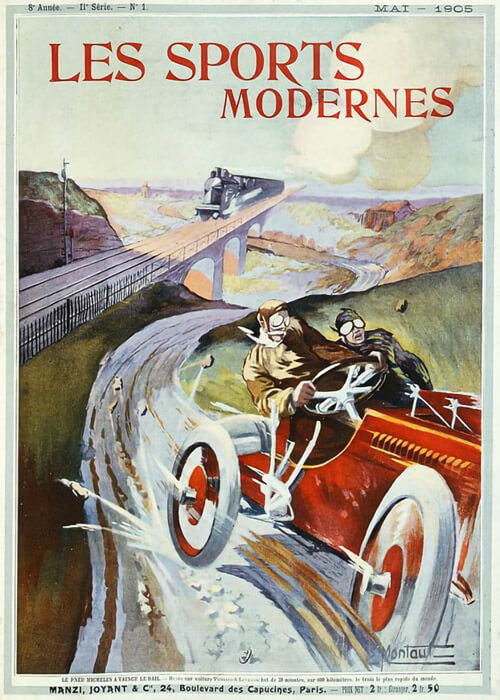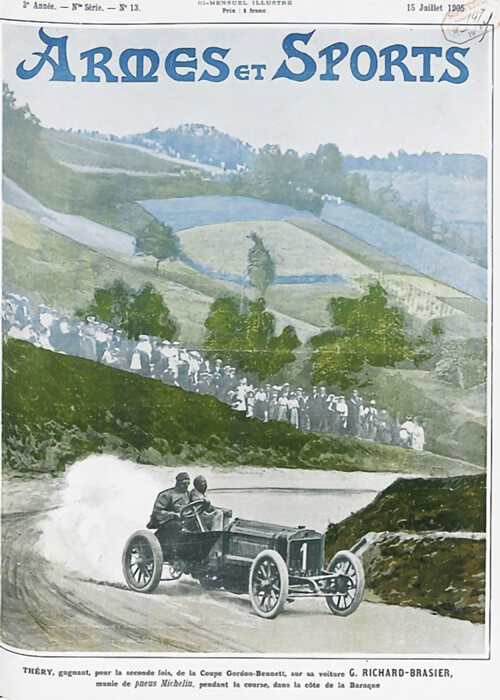This is a technically interesting article in an Austrian magazine from 1913 on how Mr. Michelin came to his idea of a „pneumatic tire“. He used these in the 1895 Paris-Bordeaux race and he introduced later the demountable tire rims. The article further stresses out the extent of industrial backgound on tire production.

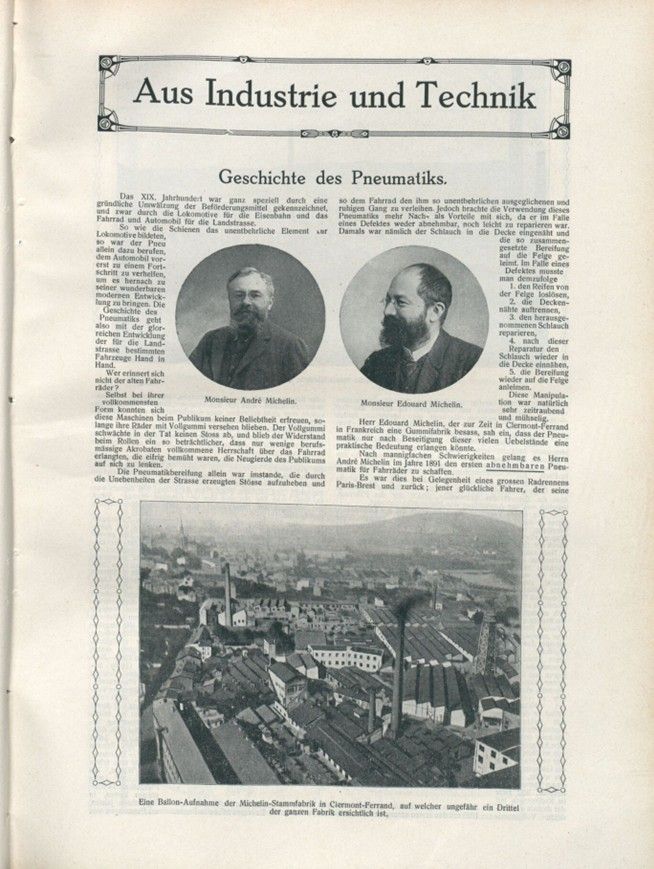


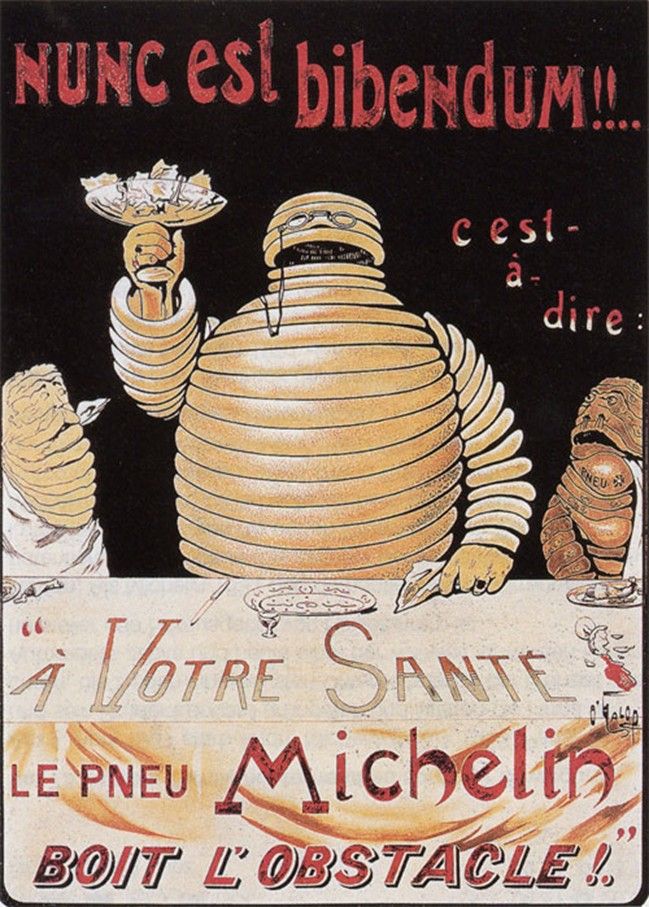
Text and fotos with courtesy of the Österreichische Nationalbibliothek (Austrian National Library) anno.onb.at.ac
Moderne Illustrierte Zeitung, 13. Jahrgang, Nr. 14/15, 1. August 1913.
Aus Industrie und Technik, Geschichte des Pneumatiks.
Das XIX. Jahrhundert war ganz speziell durch eine gründliche Umwälzung der Beförderungsmittel gekennzeichnet, und zwar durch die Lokomotive für die Eisenbahn und das Fahrrad und Automobil für die Landstraße.
So wie die Schienen das unentbehrliche Element zur Lokomotive bildeten, so war der Pneu allein dazu berufen, dem Automobil vorerst zu einem Fortschritt zu verhelfen, um es hernach zu seiner wunderbaren modernen Entwicklung zu bringen. Die Geschichte des Pneumatiks geht also mit der glorreichen Entwicklung der für die Landstraße bestimmten Fahrzeuge Hand in Hand.
Wer erinnert sich nicht der alten Fahrräder?
Selbst bei ihrer vollkommenen Form konnten sich diese Maschinen beim Publikum keiner Beliebtheit erfreuen, solange ihre Räder mit Vollgummi versehen blieben. Der Vollgummi schwächte in der Tat keinen Stoß ab, und blieb der Widerstand beim Rollen ein so beträchtlicher, dass nur wenige berufsmäßige Akrobaten vollkommene Herrschaft über das Fahrrad erlangten, die eifrig bemüht waren, die Neugierde des Publikums auf sich zu lenken.
Die Pneumatik Bereifung allein war imstande, die durch die Unebenheiten der Straße erzeugten Stöße aufzuheben und so dem Fahrrad den ihm so unentbehrlichen ausgeglichenen und ruhigen Gang zu verleihen. Jedoch brachte die Verwendung dieses Pneumatiks mehr Nach- als Vorteile mit sich, da er im Falle eines Defektes weder abnehmbar noch leicht zu reparieren war. Damals war nämlich der Schlauch in die Decke eingenäht und die so zusammengesetzte Bereifung auf die Felge geleimt. Im Falle eines Defektes musste man demzufolge:
1. den Reifen von der Felge loslösen,
2. die Deckennähte auftrennen,
3. den herausgenommenen Schlauch reparieren,
4. nach dieser Reparatur den Schlauch wieder in die Decke einnähen,
5. die Bereifung wieder auf die Felge anleimen.
Diese Manipulation war natürlich sehr zeitraubend und mühselig.
Herr Edouard Michelin, der zurzeit in Clermont-Ferrand in Frankreich eine Gummifabrik besaß, sah ein, dass der Pneumatik nur nach Beseitigung dieser vielen Übelstände eine praktische Bedeutung erlangen könnte.
Nach mannigfachen Schwierigkeiten gelang es Herrn Andre Michelin im Jahre 1891 den ersten abnehmbaren Pneumatik für Fahrräder zu schaffen.
Es war dies bei Gelegenheit eines Großen Radrennens Paris-Brest und zurück; jener glückliche Fahrer, der seine Maschine mit den ersten abnehmbaren Michelin-Pneumatiks versehen hatte, erreichte mit Leichtigkeit als Erster das Ziel — lange vor den anderen, die noch die angeleimten Reifen verwendet hatten. Dies war der erste Sieg des abnehmbaren Pneumatiks und der erste große Erfolg Michelins.
Durch dieses glänzende Resultat ermutigt, vervollkommnete Michelin seine Studien, um auch bei Pferdewagen diese neue Bereifung in Anwendung bringen zu können. So sah man am 20. Februar 1894 den ersten mit Pneus bereiften Fiaker in Paris.
Jedoch stellte diese neue Verwendung des Pneus, Michelin noch lange nicht zufrieden; er war nämlich der Überzeugung, dass die Zukunft des Automobils, gleich der des Fahrrads, lediglich von der Anwendung des Pneumatiks abhänge.
Die ersten Versuche des Automobils auf der Landstraße hatten in der Tat nicht sehr günstige Ergebnisse gezeigt. Seine Bereifung, ob aus Metall oder aus Vollgummi, übertrug dem Wagen alle Stöße und sein noch zarter Mechanismus wurde durch die Erschütterungen arg in Mitleidenschaft gezogen.
Nach zahlreichen Versuchen hatte es Michelin im Jahre 1895 so weit gebracht, dass der erste abnehmbare Pneumatik für Automobile in seiner Fabrik erzeugt wurde.
Ein Rennen zwischen Paris—Bordeaux war angesagt. Kein einziger Automobilfabrikant wollte seine Chancen auf Pneumatiks riskieren und alle weigerten sich sogar, Michelin einen Wagen zu verkaufen, mit welchem er selbst an dem Rennen teilzunehmen beabsichtigte. Da Michelin seinen ersten Autopneumatik, von welchem er sich viel versprach, doch die Gelegenheit bieten wollte, sich in einem Rennen zu behaupten, und zwar in Konkurrenz mit der damals verwendeten Vollgummi oder Eisenbereifung, war er gezwungen, sich selbst ein Automobil zu bauen, dem er den Namen „Eclair“ gab. Damals konnte man nicht verstehen, dass eine Bereifung, welche lediglich Luft enthielt, einer so massiven und schweren Maschine wie es „Eclair“ war, zu einer Großen Geschwindigkeit verhelfen sollte.
Jedoch erwiesen sich die Voraussetzungen Michelins als vollkommen zutreffend und passierte das „Eclair“ als einer der Ersten das Zielband.
Es war wieder ein epochemachender Sieg und der Anfang der glänzenden Triumphe des Pneus; es war nunmehr der Beweis seiner Kraft und außerordentlichen Geschmeidigkeit erbracht. In allen folgenden Rennen benützten die Fabrikanten die neue, von Michelin geschaffene Bereifung und damals war es, dass man für Michelin den so richtigen Namen „Vater der abnehmbaren Pneumatiks“ (Le père des demontables) geprägt hat.
Nur dem Pneu allein waren die großartigen Leistungen zu verdanken, die auf die Gebiete der Konstruktion von Automobilen seit dieser Zeit zu verzeichnen waren. Die große Elastizität der eingeschlossenen Luftschichte vermochte siegreich das zerstörende Stoßen der holprigen Landstraße abzuschwächen, und dadurch wurde die Konstruktion von weniger massiven Motoren sowie die Herstellung leichterer Automobile ermöglicht.
In dem ersten Rennen Paris—Bordeaux (1895) betrug das Gewicht pro Pferdekraft 250 Kilogramm Vollgummi. 1896 verminderte sich dieses Gewicht bei Pneumatik Bereifung bereits auf 166 Kilogramm. Im Jahre 1900, im Rennen Paris —Toulouse, verfügte man schon über Wagen, bei denen auf eine Pferdekraft 14 Kilogramm kamen. In den letzten Jahren, wo Rennwagen von 150 und sogar 200 Pferdekräften gebaut wurden, gelangte man zu dem außerordentlichen geringen Wagengewicht von 6 und 5 Kilogramm pro Pferdekraft.
Wie aus dem Vorstehenden ersichtlich, ist der Name Michelin eng mit dem gewaltigen Aufschwung der Automobilindustrie und der enormen Entwicklung des Automobilismus verknüpft.
Seit dem Tage der Erfindung des Pneumatiks war Michelin unerlässlich bemüht, seine Fabrikation zu vervollkommnen. Sowohl unter seiner umsichtigen Leitung als auch unter der seines Bruders, Herrn André Michelin, sind eine Schar Ingenieure und Arbeiter damit beschäftigt, immer neue Verbesserungen zu machen und den Pneumatik täglich geschmeidiger und praktischer zu gestalten. Hier wie überall war Michelin immer an der Spitze jedweden Fortschrittes. Er war es auch, der im Jahre 1905 den ersten, richtig erzeugten Gleitschutzmantel in den Handel brachte.
Im Jahre 1906, anlässlich des Grand Prix des A. C. F. führte er die erste abnehmbare Felge ein, welche die Zeit für die Behebung der Pneus Defekte auf ein Minimum reduziert, sodann im Jahre 1908 den Zwillingpneumatik Michelin. Endlich noch eine ganze Reihe sinnreich erdachter Zubehörteile, wie das Bolzenventil, Montier Hebel, Luftflasche und vieles andere, welche die letzten Schwierigkeiten bei Anwendung des Pneumatiks aufheben.
Solche Bemühungen sind durch glänzende Erfolge gekrönt. Das Renommee des Hauses Michelin verbreitet sich auf der ganzen Welt und seine Pneumatiks werden in internationalen Automobilkreisen geschätzt.
Um den immer steigenden Nachfragen ausländischer Automobilisten nachkommen zu können, sah sich Michelin veranlasst, außer der großen Stammfabrik in Clermont-Ferrand noch andere große Fabriken zu errichten. Es sind dies die Etablissements in Milltown in den Vereinigten Staaten und in Turin, welche die ganze Welt mit Michelin-Pneumatiks versehen.
„Bibendum“, die Verkörperung des Pneumatiks Michelin, fährt jetzt auf allen Straßen der Weltkugel, fröhlich der Menschheit seinen stolzen Grundsatz verkündend: „Nunc est bibendum“. Le pneu Michelin boit l’obstacle (Der Pneu Michelin verschluckt alle Hindernisse).
———————-
Translation by DeepL.com
From Industry and Technology – History of the pneumatic tire.
The 19th century was particularly characterized by a fundamental revolution in means of transportation, namely the locomotive for railways and the bicycle and automobile for the road.
Just as the rails were the indispensable element for the locomotive, so was the tire alone destined to help the automobile to make progress, and then to bring it to its wonderful modern development. The history of pneumatic tires thus goes hand in hand with the glorious development of vehicles intended for the road.
Who does not remember the old bicycles?
Even in their most advanced form, these machines did not enjoy great popularity with the public as long as their tires were made of solid rubber. The solid rubber did not cushion any impact, and the rolling resistance remained so considerable that only a few professional acrobats, eager to attract the curiosity of the public, were able to gain complete control over the bicycle.
Only pneumatic tires were able to absorb the shocks caused by uneven roads and thus give the bicycle the smooth and quiet ride it so urgently needed. However, the use of these tires brought more disadvantages than advantages, since they could not be removed or easily repaired in the event of a puncture. At that time, the inner tube was sewn into the cover and the assembled tire was glued to the rim. In the event of a defect, you had to:
1. detach the tire from the rim,
2. unpick the cover seams,
3. repair the removed tube,
4. re-sew the tube into the casing after the repair,
5. re-glue the tire to the rim.
These manipulations were, of course, very time-consuming and laborious.
Mr. Edouard Michelin, who owned a rubber factory in Clermont-Ferrand in France at the time, realized that only by eliminating these many drawbacks, could the pneumatic tire achieve practical significance.
After overcoming many difficulties, Mr. Andre Michelin succeeded in creating the first detachable pneumatic tire for bicycles in 1891.
It was on the occasion of a major bicycle race from Paris to Brest and back; the lucky cyclist who had his bike fitted with the first removable Michelin pneumatic tires easily reached the finish line first – long before the others who were still using the glued tires. This was the first victory of the removable pneumatic tire and the first major success for Michelin.
Encouraged by this brilliant result, Michelin continued his studies to apply this new type of tire to horse-drawn carriages. Thus, on February 20, 1894, the first cab fitted with tires was seen in Paris.
However, Michelin was far from satisfied with this new use of the tire; he was convinced that the future of the automobile, like that of the bicycle, depended solely on the use of the pneumatic tire.
The first attempts at using the automobile on a country road had not yielded very favorable results. Its tires, whether made of metal or solid rubber, transmitted all the shocks to the car and its’ still delicate mechanism was badly affected by the vibrations.
After numerous attempts, Michelin had made such progress in 1895 that the first removable pneumatic tire for automobiles was produced in his factory.
A race between Paris and Bordeaux was announced. Not a single automobile manufacturer wanted to risk their chances on pneumatic tires, and all refused to even sell Michelin a car with which he intended to participate in the race. Since Michelin wanted to equipe his first car with pneumatic tires, which he expected to do well, the opportunity to prove itself in a race, and in competition with the solid rubber or iron tires used at the time, he was forced to build himself an automobile that he named “Eclair”. At the time, it was impossible to understand how a tire that only contained air could help a machine as massive and heavy as “Eclair” to achieve great speeds.
However, Michelin’s assumptions proved to be completely accurate, and the “Eclair” was one of the first to cross the finish line. (*Not all true – GrocerJack*)
It was another epoch-making victory and the beginning of the brilliant triumphs of the tire; the proof of its strength and extraordinary flexibility had now been provided. In all subsequent races, the manufacturers used the new tires created by Michelin, and it was at that time that the name “Father of Detachable Pneumatic Tires” (Le père des demontables) was coined for Michelin.
The great achievements in the field of automobile construction since that time were only possible thanks to the tire. The great elasticity of the enclosed air layer was able to successfully cushion the destructive impact of a bumpy road, thus enabling the construction of less massive engines and lighter automobiles.
In the first Paris-Bordeaux race (1895), the weight per horsepower was 250 kilograms of solid rubber. In 1896, this weight was already reduced to 166 kilograms with pneumatic tires. In 1900, in the Paris-Toulouse race, they already had cars with 14 kilograms per horsepower. In recent years, when race cars with 150 and even 200 horsepower were built, they achieved the extraordinarily low car weight of 6 and 5 kilograms per horsepower.
As can be seen from the above, the name Michelin is closely linked to the tremendous boom in the automotive industry and the enormous development of motoring.
From the day the pneumatic tire was invented, Michelin worked tirelessly to perfect its production. Under his careful management and that of his brother, Mr. André Michelin, a host of engineers and workers, are constantly working to make new improvements and to make the pneumatic tire more pliable and practical every day. Here, as everywhere, Michelin was always at the forefront of every advance. It was also he who, in 1905, brought the first properly manufactured anti-skid tire to market.
In 1906, on the occasion of the Grand Prix des A. C. F., he introduced the first removable rim, which reduced the time needed to repair tire defects to a minimum, and then, in 1908, the twin Michelin pneumatic tire. Finally, a whole series of ingeniously designed accessories, such as the bolt valve, tire levers, air bottles and much more, which eliminate the last difficulties in using pneumatics.
Such efforts have been crowned with brilliant success. The reputation of the Michelin company is spreading all over the world and its pneumatic tires are appreciated in international automotive circles.
In order to meet the ever-increasing demand from foreign motorists, Michelin was forced to build other large factories in addition to the large parent plant in Clermont-Ferrand. These are the establishments in Milltown in the United States and in Turin, which supply the whole world with Michelin tires.
“Bibendum”, the embodiment of the Michelin pneumatic tire, now travels on all the roads of the world, happily proclaiming its proud motto to mankind: ‘Nunc est bibendum’. “Le pneu Michelin boit l’obstacle” (The Michelin tire swallows all obstacles).
Picture captions.
Page 17.
Monsieur Andre Michelin. – Monsieur Edouard Michelin.
A balloon photograph (birds‘ view) of the Michelin parent plant in Clermont-Ferrand, showing about a third of the entire factory.
Page 18.
Part of the Michelin base plant in Clermont-Ferrand.
The “Eclair” car of Mr. Michelin was used for the 1895 Paris-Bordeaux race.
in 1895, the tires were the first pneumatic tires ever made. They were Michelin tires.
Page 19.
The fleet of the Michelin factory. These cars are used to test the tires.
Map of the city of CLERMONT-FERRAND.
Area of the Michelin tire factory in 1895 – Area of the Michelin tire factory in 1913 – Workers‘ housing at the Michelin factory. Page 20. – The Michelin factory (bird’s eye view).

